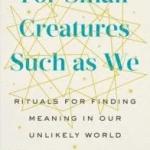 It’s That Time of Year Again
It’s That Time of Year Again
The winter holidays are upon us once again. Twinkling lights, decorated trees, candle lighting, gift giving — all the usual trimmings for this time of year. And while it’s hard to resist the charm of all this, many naturalists still approach the holiday season with a mild sense of ambiguity.
Christmas is lovely, if not over-commercialized, but for naturalists, it’s not about virgin births. Hanukkah is also beautiful, but it too is often spoken about in miraculous terms.
I see the profound meanings of both holidays. I appreciate the traditions and the symbolism. But as a naturalist, I can’t fully get on board.
When I mention this to friends, many respond by telling me that they aren’t about the religious meanings of the holidays either. And most advise me to celebrate a secular Christmas or Hanukkah as so many others do. I see their point, and it has merit, but it doesn’t leave me quite satisfied on any spiritual level.
Add to this ambiguity the layers of nostalgia that come with Christmas for so many people. Yes, adults can meaningfully enjoy these holidays, but it can be hard to rival the childhood memories, sense of anticipation, and excitement that, when looking back, seems almost magical.
A Spiritual Naturalist Alternative
So, what’s a naturalist to do this time of year?
Well, I can’t speak for all of us, but for the past few years, this naturalist has been finding increasing meaning and spiritual depth in celebrating the winter solstice. While the winter solstice may seem relatively insignificant, it has historically held significant cultural and spiritual meaning for many societies.
Now, of course, from a naturalistic perspective, the winter solstice is simply a product of the Earth’s physical properties and movements and has no inherent meaning or significance beyond this. However, while naturalism may reject the idea of any supernatural or divine forces at play in the winter solstice, it does not necessarily negate the cultural or personal significance that individuals or societies may attach to the event.
One of the most enduring symbols of the winter solstice is the importance of light. In the depths of winter, when days are short and nights are long, people have long sought ways to bring light into their lives to combat the darkness and cold.
This is reflected in the many winter solstice traditions that revolve around light, such as using candles, fireplaces, and lanterns to brighten homes and public spaces. And much of this naturally overlaps with Christmas and Hanukkah.
For many ancient cultures, the winter solstice marked the return of the sun and the renewal of life after the long, dark winter. The ancient Egyptians, for example, celebrated the winter solstice as the birthday of the sun god Ra, and the Romans held a festival called the Dies Natalis Solis Invicti (Birthday of the Unconquered Sun) to mark the event.
The druids of ancient Britain also saw the winter solstice as a time of renewal and rebirth, and it was an important event in their religious calendar. I lived in Ireland for several years and was able to visit Newgrange, an ancient Irish religious monument illuminated by the sun on the morning of the solstice.
We can certainly learn from our ancestors, but the solstice is still relevant today.
Some people mark the occasion with ceremonies or by observing traditional customs. In contrast, others enjoy coming together with friends and family and celebrating the start of the winter season.
In some parts of the world, the winter solstice is also a time for contemplation and introspection as people take stock of the year that has passed and look forward to the year ahead.
I know many pagans and others who celebrate the solstice and have crafted their own traditions and rituals. There are many practices to explore and adapt for our own purposes.
One of the more iconic symbols of the winter solstice is the Yule log, traditionally burned on the longest night of the year to provide warmth and light. The Yule log was also thought to have protective and purifying powers, and it was often decorated with holly, ivy, and mistletoe to bring luck and prosperity to the home.
In some cultures, the Yule log was also associated with rebirth, as it was believed that the sparks and embers of the burning log represented the seeds of new life and growth.
Another popular winter solstice tradition is the exchange of gifts, which has its roots in ancient Roman and Scandinavian customs. The Romans, for example, exchanged gifts during the festival of Saturnalia, which was held in honor of the god Saturn and took place around the time of the winter solstice.
In Scandinavia, the winter solstice was marked by the celebration of Yule, during which people exchanged gifts and feasted on special foods such as roast pork and spiced ale.
Decorated trees, candles in windows, festive meals — there are indeed many options to consider.
A Season of Light
Despite the many differences between ancient and modern celebrations of the winter solstice, Christmas, and Hanukkah, the importance of light remains a constant theme.
Whether it is the warmth and comfort of a fire, the light of a candle, or the twinkle of holiday lights, this is a time when people come together to celebrate the return of the sun and the promise of new beginnings.
For many people, the winter solstice holds a great deal of symbolic meaning, whether as a time of renewal and rebirth or as a moment to come together with friends and family to celebrate the start of the winter season.
From a spiritual naturalistic perspective, the winter solstice is also an opportunity to appreciate and marvel at the natural world. The event reminds us of the Earth’s place in the solar system and the intricate interplay of physical forces that shape our planet.
It can also serve as a reminder of the beauty and wonder of the natural world, as the winter solstice often coincides with the arrival of winter weather and the transformation of the landscape.
While naturalism may reject the idea of any supernatural or divine forces at play in the events and celebrations of this time of year, it does not necessarily negate the spiritual, cultural, or personal significance that individuals or societies may attach to these holidays.
So, I wish you a happy solstice or a happy and healthy holiday of your choice. May we all find meaning and joy in this season of light.
__________
Subscribe to The Spiritual Naturalist Society
Learn about Membership in the Spiritual Naturalist Society
The Spiritual Naturalist Society works to spread awareness of spiritual naturalism as a way of life, develop its thought and practice, and help bring together like-minded practitioners in fellowship.
SNS strives to include diverse voices within the spectrum of naturalistic spirituality. Authors will vary in their opinions, terms, and outlook. The views of no single author therefore necessarily reflect those of all Spiritual Naturalists or of SNS.
















